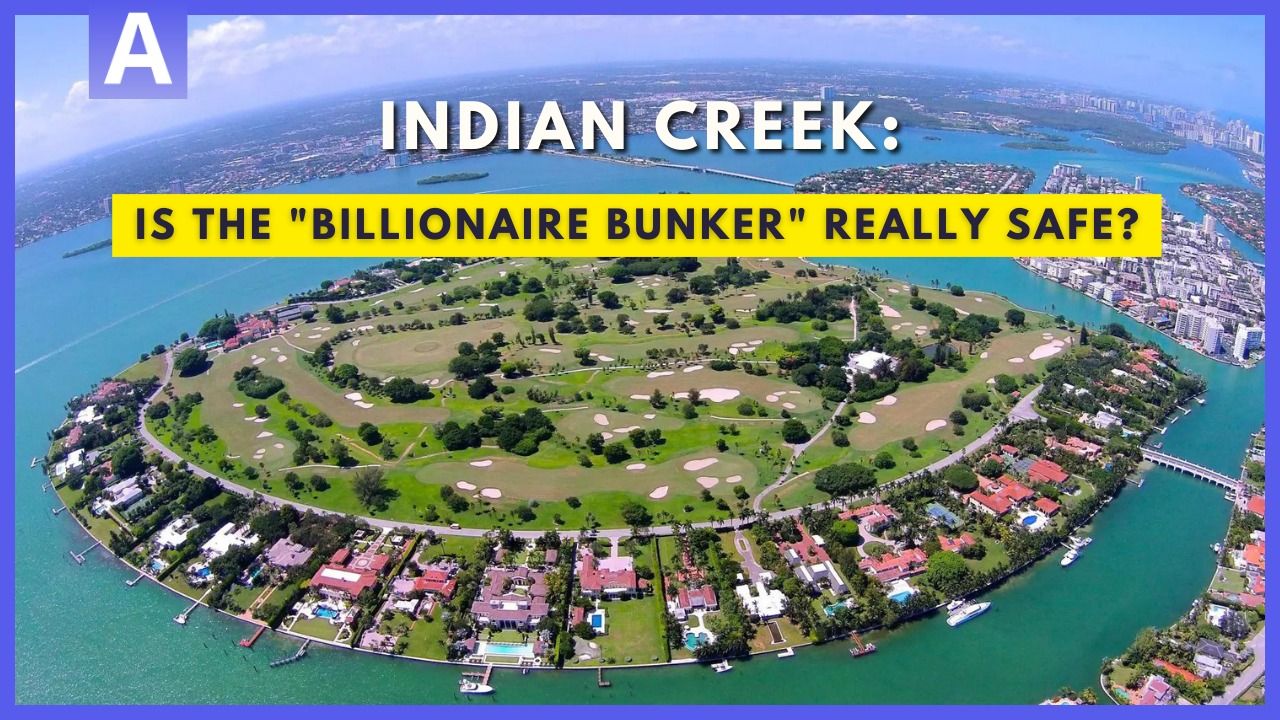Indian Creek: Is the "Billionaire Bunker" Really Safe?
Indian Creek is a posh magnet for billionaires like Bezos due to its exclusivity and presumed safety. But climate change is a looming threat over the fancy island and its luxury properties worth millions.

In the rare air of exclusivity, where private islands cater to the world's richest, Indian Creek Village in Florida stands out as a modern beacon of luxury property. The real estate market reached unprecedented heights last week, when Jeff Bezos, the world's second richest person, acquired his second waterfront property for $79 million.
As Indian Creek becomes a playground for billionaires like Bezos, it faces environmental and climate threats that can compromise the safety of these multi-million luxury properties.
A playground for the privileged
Indian Creek, a serene island north of Miami Beach, boasts private streets that only admit residents and their invited guests. In 2021, Zillow crowned this guard-gated enclave, often dubbed the "Billionaire Bunker," as the most expensive city in the United States. The list of neighbors reads like a who's who of wealth and influence, including billionaire Carl Icahn, hedge funder Eddie Lampert, power couple Ivanka Trump and Jared Kushner, and football legend Tom Brady. The exclusivity of this community has made it a magnet for the super-rich seeking not only privacy, but also an idyllic waterfront lifestyle.
The billionaire exodus to Miami-Dade
Jeff Bezos isn't the only titan of industry eyeing Miami-Dade County for luxury acquisitions. Billionaire hedge fund manager Ken Griffin and former Google CEO Eric Schmidt have also joined the ranks of those investing heavily in the region. The allure of Miami's tropical climate, coupled with the promise of expansive waterfront properties, has sparked a billionaire exodus from traditional hubs like New York and Silicon Valley.
Billionaire Bunker vs climate change
Beneath the veneer of opulence lies a pressing safety concern: the vulnerability of Indian Creek to the impacts of climate change and natural disasters. Situated along the coast, the island faces the dual threat of hurricanes and rising sea levels.
Storms and hurricanes
Given its coastal location in South Florida, Indian Creek is susceptible to hurricanes and tropical storms. These weather events can bring strong winds, heavy rainfall, and storm surges, leading to flooding, property damage, and disruptions to daily life.
Sea level rise and storm surge
Like many coastal areas, Indian Creek faces the long-term threat of sea level rise due to climate change. Rising sea levels can contribute to increased flooding, erosion, and other environmental challenges. The island maintains an average elevation of 7 feet. According to NOAA's Intermediate-High scenario, the sea level in the area is projected to rise by 1.28 feet by 2050.
During hurricanes and tropical storms, storm surges can occur, causing a rapid and temporary rise in sea level. This can lead to coastal flooding and damage to waterfront properties.
Notably, storm surges can further elevate water levels significantly. For instance, during Hurricane Katrina, local sea levels surged by up to 28 feet, as reported by NOAA.
Coastal flooding
As hurricanes become more frequent and intense, and sea levels continue to rise, the risk of flooding and property damage is escalating. According to the risk assessment conducted by Augurisk, the risk of coastal flooding of properties on Indian Creek is severe (70%).
The exclusivity that draws billionaires to Indian Creek also places their investments at the mercy of nature's changing tides. The map below shows that most waterfront properties on the island are at risk of coastal flooding.
Balancing luxury with environmental responsibility
As Indian Creek transforms into a haven for the world's wealthiest, the challenge lies in harmonizing luxury living with environmental responsibility. Sustainable building practices, resilient infrastructure, and community-wide conservation efforts are imperative to safeguard the future of this island, and many other island communities around the world.
Eco-mansions and sustainable living
Amidst the conspicuous consumption, NFL star Tom Brady has taken a different approach. Having paid $17 million for a property, Brady is demolishing the existing structure to build an "eco-mansion." This signals a growing trend among the ultra-rich to embrace sustainable living and eco-friendly construction practices, perhaps indicative of a broader shift in environmental consciousness within the elite echelons.
Risk assessment for properties
As billionaires shape the skyline, the island's fate intertwines with the urgent need for climate stewardship and sustainable practices, far beyond the private streets of this exclusive enclave.
The fragile position of multi-million dollar estates in the face of climate change underscores the need for environmental risk assessment of all types of properties.
A detailed risk assessment for any property in the U.S. is available at Augurisk.
